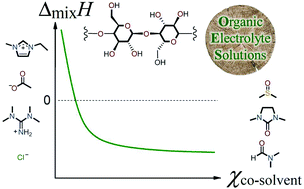Organic electrolyte solutions as versatile media for the dissolution and regeneration of cellulose
Abstract
Organic electrolyte solutions – mixtures of a (room-temperature) ionic liquid with a neutral, organic, polar co-solvent – are attracting increasing attention as solvents for the regeneration and derivatisation of cellulose. Despite advantages (in comparison to simple ionic liquid analogues) associated with rapid or instantaneous dissolution, reduced viscosity, enhanced thermal stability and fine-tunable physicochemical properties, a firm understanding of the precise solvent–solute interactions and the relative kinetic versus thermodynamic contributions to dissolution remains elusive. The incorporation of a co-solvent introduces an additional layer of complexity, therefore an informed choice of both ionic liquid and co-solvent is necessary in order to achieve the desired properties. This article first provides an overview of the structure and bonding properties of native and non-native cellulose allomorphs, and a brief history of strategies for cellulose dissolution. Subsequently, organic electrolyte solutions are introduced as versatile solvents for cellulose, and the underpinning thermodynamic, kinetic and mechanistic phenomena behind cellulose solubility are critically discussed. The final sections summarize recent advances in the development of organic electrolyte technologies for derivatisation and regeneration of cellulose and critically discuss whether organic electrolytes can, or could be, rightly regarded as ‘green solvents’.

- This article is part of the themed collection: International Symposium on Green Chemistry 2017


 Please wait while we load your content...
Please wait while we load your content...